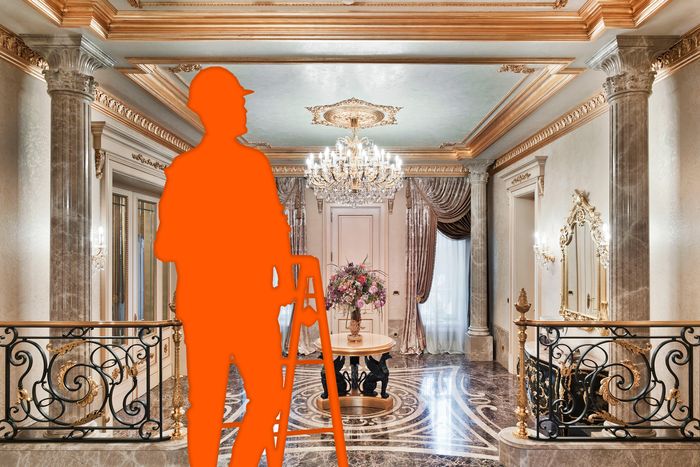
In New York City, luxury real estate is as much a vehicle to hide one’s wealth as it is to flaunt it. Recently, such properties have come under new scrutiny as city officials call for seizing the apartments of known Russian oligarchs. “For years, Manhattan has been one of the most popular safe harbors for Russian oligarchs to park their cash, especially via ultra-high-end apartments,” Manhattan Borough President Mark Levine tweeted on Monday.
And with the “ultra-high-end” market comes a corresponding phenomenon: the ultra-high-end renovation. These projects, like the owners — or owning entities — are often shrouded in secrecy. The architects, contractors, and carpenters sign NDAs and build out homes that may never house an actual tenant. But when it comes to service, what do these clients ask for? Do you even meet your boss?
Curbed spoke to a contractor who does luxury wood and metal architectural work to get a sense of the job (“Sometimes you’ve got to shut down Fifth Avenue and hire a crane”) and the clientele (“bad taste but tons of money”).
This interview has been edited and condensed.
The privacy
On crazy-big projects, you sign NDAs, and they’re really restrictive about access. I’ve worked on two or three penthouses and big skyscrapers, and there are crazy security protocols. If you’re a subcontractor of a subcontractor, you don’t ever get anywhere near anyone, and you only see construction people. I’ve worked on job sites where part of the NDA is that you can’t take photos — I’ve seen a carpenter get caught taking pictures and then immediately get escorted out of the building by security.
With celebrities, you might know it’s their place — it’s rumored — but you don’t ever see them. But for oligarchs owning real estate done through shell companies, you would never know who it is. These types of build-outs or investments are just parking money somewhere. Maybe the developers themselves will have a relationship with the end client, but I don’t know. I’ve been in homes and worked on projects that are worth tens of millions of dollars, and if I really wanted to find out who they belonged to in the end, I’m not even sure who I’d talk to.
For a smaller $7 million project we did not get, I had to sign an NDA just to look at the architectural drawings. The actual clients came to my shop, which was incredibly unusual. But if you Google them or Google that property to figure out who you’re actually working for, you don’t know. There were no last names, and that property is in a holding company.
How it gets done
It’s really wildly demanding. People with that sort of money skirt building codes and get around things like city ordinances on how much you can work and how much noise you can make. If they decide they really want to go fast, they’ll put it in the contract, and you’ll work until shit gets done. There are insane deadlines where you get 130-page contracts and it’s like, If you fuck this up, a team of lawyers will litigate you out of existence.
A not unusual practice is building stuff that will pass inspection only to be removed after it’s given a certificate of occupancy. For example, there’s lots of rules about stairs, like code around open gaps between balusters on railings. Frequently, they want a big wide-open railing, so we’ll build a railing that is filled in, and after inspection, it comes out.
Sometimes you’ve got to shut down Fifth Avenue and hire a crane to haul all this stuff into a building, which is crazy. Just so they can get all their furniture into their apartment!
When I’m working on smaller-scale projects directly with the client, there’s the general shit that happens with wealthy people: They wanna be over your shoulder and change their mind all the time. They’ll want to make changes and not pay for them, and there’s a type of service they expect to be given.
What they ask for
It would actually be more fun if they wanted crazier things, but what ends up happening is that architects design these really interesting things and a lot of that gets pushed out in the process. The client will see some shit they want in a magazine and know that other people like it, so instead of doing something interesting, they spend insane piles of money on materials and hiding the workmanship. Since they don’t want to see how it’s made or held together, you get really clinical spaces that are worth tens or hundreds of thousands of dollars for a finished product that is rather bland most of the time. It always sticks out how much money they spend for the stuff to come out so normal.
One project I worked on had an 1,800-pound door, and they just wanted it to work a certain way. So we had to order custom-made $6,000 hinges to make it go. There’s a lot of effort, time, and money that’s put into coming up with customized solutions to solving logistical and engineering problems that ultimately suit a pretty boring aesthetic. Or it’s really weird stuff, like a normal McMansion but everything is gold plated or imported stone from weird quarries in Spain. They have bad taste but tons of money and buy all this really expensive stuff that ends up looking like shit.





